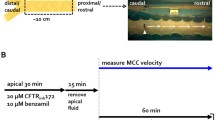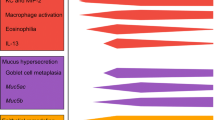Abstract
Background
Cystic fibrosis (CF) is a syndrome caused by mutations in the cystic fibrosis transmembrane regulator (CFTR) gene. Despite advances in our understanding of the molecular pathogenesis of CF, the link between CFTR gene mutations and the pathogenesis of CF lung disease remains poorly defined. CFTR has been assigned a number of putative functions that may contribute to innate airway defense, including the regulation of adenosine 5′-triphosphate (ATP) release into the extracellular environment. Because extracellular ATP and uridine 5′-triphosphate (UTP) may regulate airway mucociliary clearance via interaction with luminal P2Y2 receptors, the loss of CFTR-mediated nucleotide release could explain the defect in CF airway defense.
Materials and Methods
We tested the physiologic importance of CFTR-mediated nucleotide release in vivo by directly measuring levels of ATP and UTP in nasal airway surface liquid from normal and CF subjects. Because these basal nucleotide levels reflect the net activities of nucleotide release and metabolic pathways, we also measured constitutive rates of nucleotide release and metabolism on well-differentiated normal and CF airway cultures in vitro. The measurement of ATP release rates were paralleled by in vivo studies employing continuous nasal perfusion in normal and CF subjects. Finally, the regulation of ATP release by isoproterenol and methacholine-stimulated submucosal gland secretion was tested.
Results
These studies revealed that steady-state ATP and UTP levels were similar in normal (470 ± 131 nM and 37 ± 7 nM, respectively) and CF (911 ± 199 nM and 33 ± 12 nM, respectively) subjects. The rates of both ATP release and metabolism were also similar in normal and CF airway epithelia both in vitro and in vivo. Airway submucosal glands did not secrete nucleotides, but rather, secreted a soluble nucleotidase in response to cholinergic stimuli.
Conclusion
The concentration of ATP in airway surface liquid is in a range that is relevant for the activation of airway nucleotide receptors. However, despite this finding that suggests endogenous nucleotides may be important for the regulation of mucociliary clearance, our data do not support a role for CFTR in regulating extracellular nucleotide concentrations on airway surfaces.





Similar content being viewed by others
References
Anderson MP, Gregory RJ, Thompson S, et al. (1991) Demonstration that CFTR is a chloride channel by alteration of its anion selectivity. Science 253: 202–205.
Bear CE, Li CH, Kartner N, et al. (1992) Purification and functional reconstitution of the cystic fibrosis transmembrane conductance regulator (CFTR). Cell 68: 809–818.
Stutts MJ, Canessa CM, Olsen JC, et al. (1995) CFTR as a cAMP-dependent regulator of sodium channels [see comments]. Science 269: 847–850.
Stutts MJ, Rossier BC, Boucher RC. (1997) Cystic fibrosis transmembrane conductance regulator inverts protein kinase A-mediated regulation of epithelial sodium channel single channel kinetics. J. Biol. Chem. 272: 14037–14040.
Boucher RC. (1994) Human airway ion transport. Part one. Am. J. Respir. Crit Care Med. 150: 271–281.
Boucher RC. (1994) Human airway ion transport. Part two. Am. J. Respir. Crit Care Med. 150: 581–593.
Reisin IL, Prat AG, Abraham EH, et al. (1994) The cystic fibrosis transmembrane conductance regulator is a dual ATP and chloride channel. J. Biol. Chem. 269: 20584–20591.
Schwiebert EM, Egan ME, Hwang TH, et al. (1995) CFTR regulates outwardly rectifying chloride channels through an autocrine mechanism involving ATP. Cell 81: 1063–1073.
Prat AG, Reisin IL, Ausiello DA, Cantiello HF. (1996) Cellular ATP release by the cystic fibrosis transmembrane conductance regulator. Am. J. Physiol. 270: C538–C545.
Sugita M, Yue Y, Foskett JK. (1998) CFTR Cl-channel and CFTR-associated ATP channel: distinct pores regulated by common gates. EMBO J. 17: 898–908.
Jiang Q, Mak D, Devidas S, et al. (1998) Cystic fibrosis transmembrane conductance regulator-associated ATP release is controlled by a chloride sensor. J. Cell Biol. 143: 645–657.
Sprague RS, Ellsworth ML, Stephenson AH, Kleinhenz ME, Lonigro AJ. (1998) Deformation-induced ATP release from red blood cells requires CFTR activity. Am. J. Physiol. 275: H1726–H1732.
Cantiello HF, Jackson GR, Grosman CF, et al. (1998) Electrodiffusional ATP movement through the cystic fibrosis transmembrane conductance regulator. Am. J. Physiol. 274: C799–C809.
Taylor AL, Kudlow BA, Marrs KL, Gruenert DC, Guggino WB, Schwiebert EM. (1998) Bioluminescence detection of ATP release mechanisms in epithelia. Am. J. Physiol. 275: C1391–C1406.
Bennett WD, Olivier KN, Zeman KL, Hohneker KW, Boucher RC, Knowles MR. (1996) Effect of uridine 5′-triphosphate plus amiloride on mucociliary clearance in adult cystic fibrosis. Am. J. Respir. Crit. Care Med. 153: 1796–1801.
Olivier KN, Bennett WD, Hohneker KW, et al. (1996) Acute safety and effects on mucociliary clearance of aerosolized uridine 5′-triphosphate +/− amiloride in normal human adults. Am. J. Respir. Crit. Care Med. 154: 217–223.
Evans JH, Sanderson MJ. (1999) Intracellular calcium oscillations regulate ciliary beat frequency of airway epithelial cells. Cell Calcium 26: 103–110.
Korngreen A, Priel Z. (1996) Purinergic stimulation of rabbit ciliated airway epithelia: control by multiple calcium sources. J. Physiol. (Lond) 497(Pt 1): 53–66.
Uzlaner N, Priel Z. (1999) Interplay between the NO pathway and elevated [Ca2+]i enhances ciliary activity in rabbit trachea. J. Physiol. (Lond) 516(Pt 1): 179–190.
Knowles MR, Clarke LL, Boucher RC. (1991) Activation by extracellular nucleotides of chloride secretion in the airway epithelia of patients with cystic fibrosis [see comments]. N. Engl. J. Med. 325: 533–538.
Stutts MJ, Fitz JG, Paradiso AM, Boucher RC. (1994) Multiple modes of regulation of airway epithelial chloride secretion by extracellular ATP. Am. J. Physiol. 267: C1442–C1451.
Lethem MI, Dowell ML, van Scott M. (1993). Nucleotide regulation of goblet cells in human airway epithelial explants: normal exocytosis in cystic fibrosis. Am. J. Respir. Cell Mol. Biol. 9: 315–322.
Abdullah LH, Davis SW, Burch L, et al. (1996) P2u purinoceptor regulation of mucin secretion in SPOC1 cells, a goblet Cell line from the airways. Biochem. J. 316(Pt 3): 943–951.
Abraham EH, Prat AG, Gerweck L, et al. (1993) The multidrug resistance (mdr1) gene product functions as an ATP channel. Proc. Natl. Acad. Sci. USA 90: 312–316.
Watt WC, Lazarowski ER, Boucher RC. (1998) Cystic fibrosis transmembrane regulator-independent release of ATP. Its implications for the regulation of P2Y2 receptors in airway epithelia. J. Biol. Chem. 273: 14053–14058.
Reddy MM, Quinton PM, Haws C, et al. (1996) Failure of the cystic fibrosis transmembrane conductance regulator to conduct ATP. Science 271: 1876–1879.
Grygorczyk R, Hanrahan JW. (1997) CFTR-independent ATP release from epithelial cells triggered by mechanical stimuli. Am. J. Physiol 272: C1058–C1066.
Grygorczyk R, Tabcharani JA, Hanrahan JW. (1996) CFTR channels expressed in CHO cells do not have detectable ATP conductance. J. Membr. Biol. 151: 139–148.
Li C, Ramjeesingh M, Bear CE. (1996) Purified cystic fibrosis transmembrane conductance regulator (CFTR) does not function as an ATP channel. J. Biol. Chem. 271: 11623–11626.
Lazarowski ER, Harden TK. (1999) Quantitation of extracellular UTP using a sensitive enzymatic assay. Br. J. Pharmacol. 127: 1272–1278.
Lazarowski ER, Homolya L, Boucher RC, Harden TK. (1997) Direct demonstration of mechanically induced release of cellular UTP and its implication for uridine nucleotide receptor activation. J. Biol. Chem. 272: 24348–24354.
Kaulbach HC, White Mv, Igarashi Y, Hahn BK, Kaliner MA. (1993) Estimation of nasal epithelial lining fluid using urea as a marker. J. Allergy Clin. Immunol. 92: 457–465.
Matsui H, Randell SH, Peretti SW, Davis CW, Boucher RC. (1998) Coordinated clearance of periciliary liquid and mucus from airway surfaces. J. Clin. Invest. 102: 1125–1131.
Hampp R. (1985) Luminometric method. In Bergmeyer J, Grossl M (eds.) Metabolites 2: Tri- and Dicarboxylic Acid, Purines, Pyrimidines and Derivatives, Coenzymes, Inorganic Compounds. VCH Publishers, Deerfield Beach, FL, pp. 370–379.
Burnstock G, Cocks T, Kasakov L, Wong HK. (1978) Direct evidence for ATP release from non-adrenergic, non-cholinergic (“purinergic”) nerves in the guinea-pig taenia coli and bladder. Eur. J. Pharmacol. 49: 145–149.
Kasakov L, Ellis J, Kirkpatrick K, Milner P, Burnstock G. (1988) Direct evidence for concomitant release of noradrenaline, adenosine 5′-triphosphate and neuropeptide Y from sympathetic nerve supplying the guinea-pig vas deferens. J. Auton. Nerv. Syst. 22: 75–82.
Hollins B, Ikeda SR. (1997) Heterologous expression of a P2x-purinoceptor in rat chromaffin cells detects vesicular ATP release. J. Neurophysiol. 78: 3069–3076.
Engelhardt JF, Yankaskas JR, Ernst SA, et al. (1992) Submucosal glands are the predominant site of CFTR expression in the human bronchus. Nat. Genet. 2: 240–248.
Picher M, Cote YP, Beliveau R, Potier M, Beaudoin AR. (1993) Demonstration of a novel type of ATP-diphosphohydrolase (EC 3.6.1.5) in the bovine lung. J. Biol. Chem. 268: 4699–4703.
Plesner L. (1995) Ecto-ATPases: identities and functions. Int. Rev. Cytol. 158: 141–214.
Abraham EH, Okunieff P, Scala S, et al. (1997) Cystic fibrosis transmembrane conductance regulator and adenosine triphosphate [letter]. Science 275: 1324–1326.
Schwiebert EM. (1999) ABC transporter-facilitated ATP conductive transport. Am. J. Physiol. 276: C1–C8.
Devidas S, Guggino WB. (1997) The cystic fibrosis transmembrane conductance regulator and ATP. Curr. Opin. Cell Biol. 9: 547–552.
Cole P. (1982) Upper respiratory airflow. In: Proctor DF, Andersen I (eds.) The Nose: Upper Airway Physiology and the Atmospheric Environment. Elsevier Biomedical Press B.V., Amsterdam, pp. 163–189.
Knowles MR, Clarke LL, Boucher RC. (1992) Extracellular ATP and UTP induce chloride secretion in nasal epithelia of cystic fibrosis patients and normal subjects in vivo. Chest 101: 60S–63S.
Clarke LL, Harline MC, Otero MA, et al. (1999) Desensitization of P2Y2 receptor-activated transepithelial anion secretion. Am. J. Physiol. 276: C777–C787.
Strobel RS, Nagy AK, Knowles AF, Buegel J, Rosenberg MD. (1996) Chicken oviductal ecto-ATP-diphosphohydrolase. Purification and characterization. J. Biol. Chem. 271: 16323–16331.
Nagy AK, Knowles AF, Nagami GT. (1998) Molecular cloning of the chicken oviduct ecto-ATP-diphosphohydrolase. J. Biol. Chem. 273: 16043–16049.
Ronquist G, Brody I. (1985) The prostasome: its secretion and function in man. Biochim. Biophy. Acta 822: 203–218.
Beaudoin AR, Vachereau A, Grondin G, St Jean P, Rosenberg MD, Strobel R. (1986) Microvesicular secretion, a mode of Cell secretion associated with the presence of an ATP-diphosphohydrolase. FEBS Lett. 203: 1–2.
Acknowledgments
This work was supported by the Cystic Fibrosis Foundation (CFF L543).
Author information
Authors and Affiliations
Corresponding author
Rights and permissions
About this article
Cite this article
Donaldson, S.H., Lazarowski, E.R., Picher, M. et al. Basal Nucleotide Levels, Release, and Metabolism in Normal and Cystic Fibrosis Airways. Mol Med 6, 969–982 (2000). https://doi.org/10.1007/BF03401831
Accepted:
Published:
Issue Date:
DOI: https://doi.org/10.1007/BF03401831




